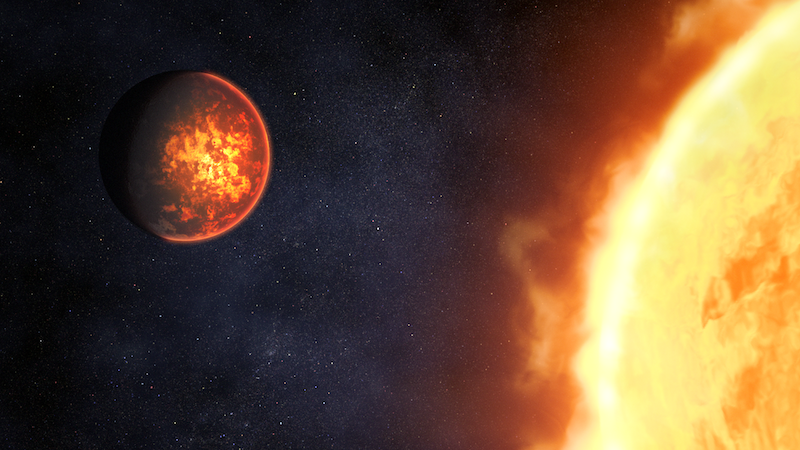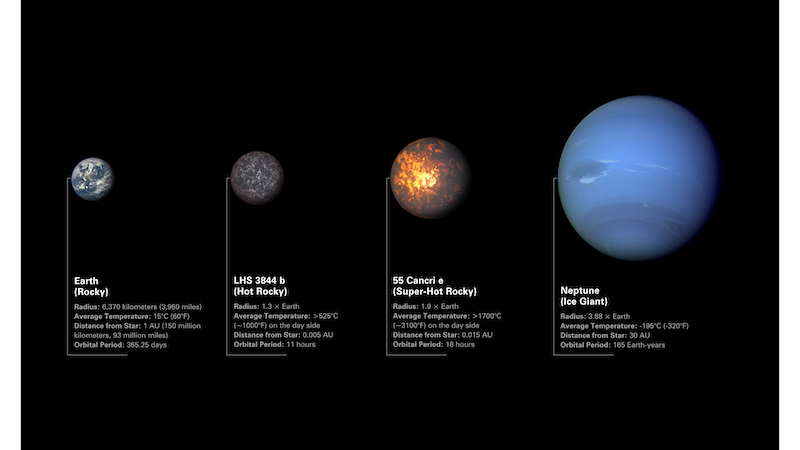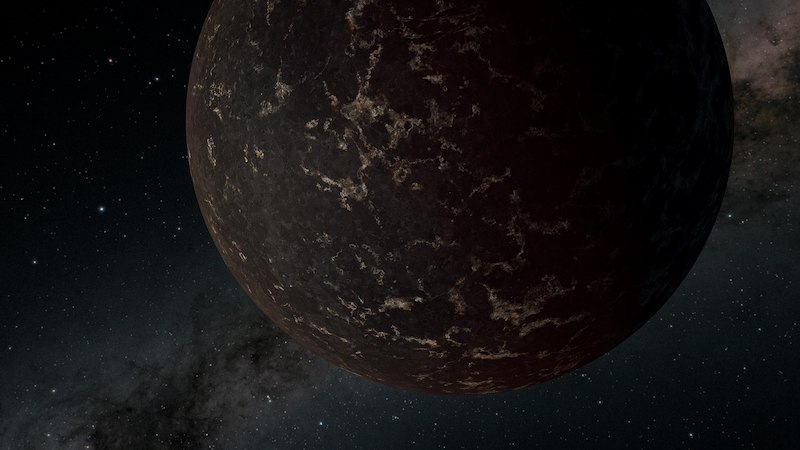
Hot, rocky exoplanets
NASA’s Webb telescope – successor to the Hubble Space Telescope – is almost ready to begin its science mission! Webb will observe stars, galaxies, nebulae, exoplanets and even objects in our own solar system. Some of the earliest, and most exciting, targets will be rocky exoplanets. Some of them are nearly the same size as Earth, while others are a bit larger, aka super-Earths. There are two super-Earths in particular that Webb will study in its first year of operations: 55 Cancri e and LHS 3844 b. Both are hot worlds, orbiting close to their stars.
While both planets are super-Earths, they are very different from each other. This makes them ideal targets for Webb. The telescope will study the geologic diversity of rocky planets orbiting other stars. Scientists want to better understand the similarities and differences between them and how they evolved.
55 Cancri e: Lava world
First, 55 Cancri e. Discovered in 2004, it is 41 light-years away and orbits a sun-like star. It is about eight times the mass of Earth and 1.9 times Earth’s radius. The planet orbits very close to its star, completing an orbit in only 0.7 days, or less than 18 hours.
Due to being so close to its star, it is a scorching world. So hot, in fact, that its temperatures are more than enough to melt rock. Scientists estimate its average temperature to be about 4,400 degrees Fahrenheit (2,400 degrees Celsius). So, scientists say that the day side of the planet is likely covered in lava. We say day side, since 55 Cancri e is thought to be tidally locked, with the same side always facing its star. This is similar to how the moon is tidally locked to Earth.
In February 2016, NASA announced that the Hubble Space Telescope had detected hydrogen and helium (and hints of hydrogen cyanide), but no water vapor, in the atmosphere of 55 Cancri e.
The 55 Cancri system has five known planets altogether.

Heat anomaly
Normally, the part of a tidally locked planet that faces its star most directly should be the hottest. On 55 Cancri e, however, that hottest region seems to be offset a bit from that spot on the planet. NASA’s Spitzer Space Telescope made that observation. Spitzer ended its mission on January 30, 2020.
Scientists don’t know yet why this happens, but they have ideas. One possibility is a thick atmosphere that is able to move heat around. As Renyu Hu of NASA’s Jet Propulsion Laboratory (JPL) explained:
55 Cancri e could have a thick atmosphere dominated by oxygen or nitrogen.
Astronomers will use Webb to study the thermal emission spectrum of the day side of the planet. They will do so using the Near-Infrared Camera (NIRCam) and Mid-Infrared Instrument (MIRI). Hu said:
If it has an atmosphere, [Webb] has the sensitivity and wavelength range to detect it and determine what it is made of.

Is 55 Cancri e tidally locked … or not?
There is still a possibility, though, that 55 Cancri e is not tidally locked. If that is the case, then it might rotate three times for every two orbits (called a 3:2 resonance). This is similar to the planet Mercury. If so, then the planet would have a day-night cycle like Earth and most other planets in our solar system. Alexis Brandeker at Stockholm University said:
That could explain why the hottest part of the planet is shifted. Just like on Earth, it would take time for the surface to heat up. The hottest time of the day would be in the afternoon, not right at noon.
Brandeker and his team can test this hypothesis using Webb. They will use NIRCam to measure the heat emitted from the lit side of 55 Cancri e during four different orbits.
If this is true, then 55 Cancri e might have a rather unique “hydrological cycle” where the surface rock would get hot and melt during the day. It could even vaporize, producing a thin atmosphere. The vapor would cool down in the evening, forming “rain” composed of droplets of lava. At night, those droplets would solidify again.
LHS 3844 b: A hot, airless world
This planet is also hot, but not quite hot enough for rock to melt. Even though it orbits very close to its star, the star itself is cooler than our sun. Therefore, the planet isn’t quite as scorching as it might otherwise be.
LHS 3844 b orbits its star in only 11 hours. It was discovered in 2019 and is just a little farther away than 55 Cancri e, at 49 light-years. It is also closer to Earth in size and mass, with a radius of 1.3 times Earth and a mass 2.25 times Earth’s.
Based on Spitzer observations, however, it has little, if any, atmosphere.
Webb will use spectroscopy to study the planet’s rocky surface. That will tell astronomers what the surface is composed of. According to Laura Kreidberg at the Max Planck Institute for Astronomy:
It turns out that different types of rock have different spectra. You can see with your eyes that granite is lighter in color than basalt. There are similar differences in the infrared light that rocks give off.
In addition, Kreidberg’s team will use MIRI to analyze the thermal emission spectrum of the day side of LHS 3844 b. Then, that spectra will be compared to spectra of known rocks, such as basalt and granite. If it turns out that the planet is volcanically active, the spectra could also reveal trace amounts of volcanic gases.

Not just hot, rocky exoplanets
The study of 55 Cancri e and LHS 3844 b will provide valuable clues about rocky super-Earth type planets. In particular, it will tell us about other such worlds – and perhaps like the early Earth – when they are still hotter in their earlier stages of formation. Those results can then be extrapolated to other rocky planets as well, including ones that are close in size to Earth. The seven worlds of TRAPPIST-1 are a prime example, which Webb will also be observing. All seven planets are nearly the same size as Earth, and some of them may have significant amounts of water.
Bottom line: Two of the Webb telescope’s first science targets will be hot, rocky super-Earth worlds within 50 light-years of Earth: 55 Cancri e and LHS 3844 b. The data will help scientists better understand how these types of planets form and evolve, and whether any of them could be habitable.
The post Hot, rocky exoplanets among Webb’s 1st targets first appeared on EarthSky.
0 Commentaires